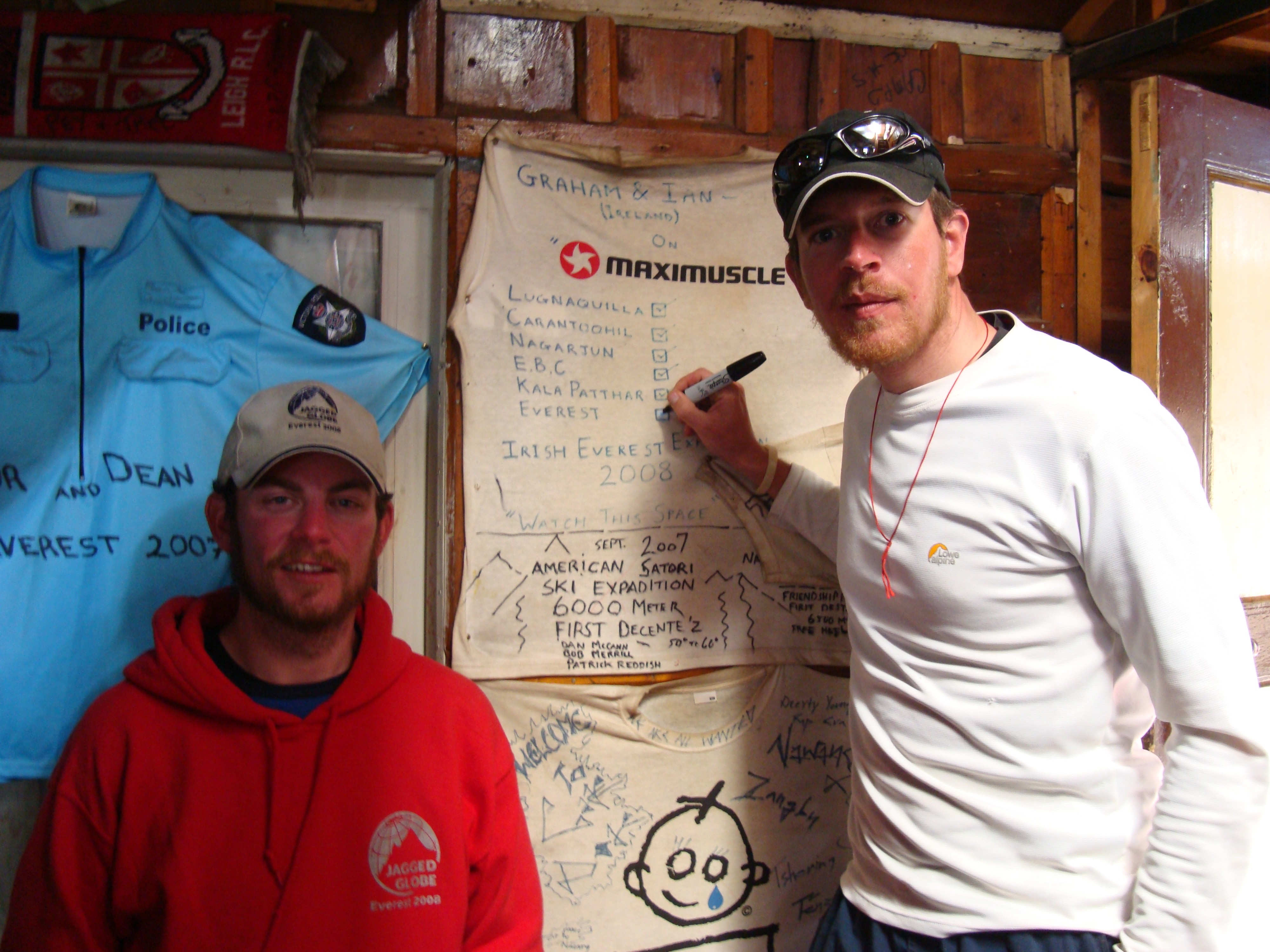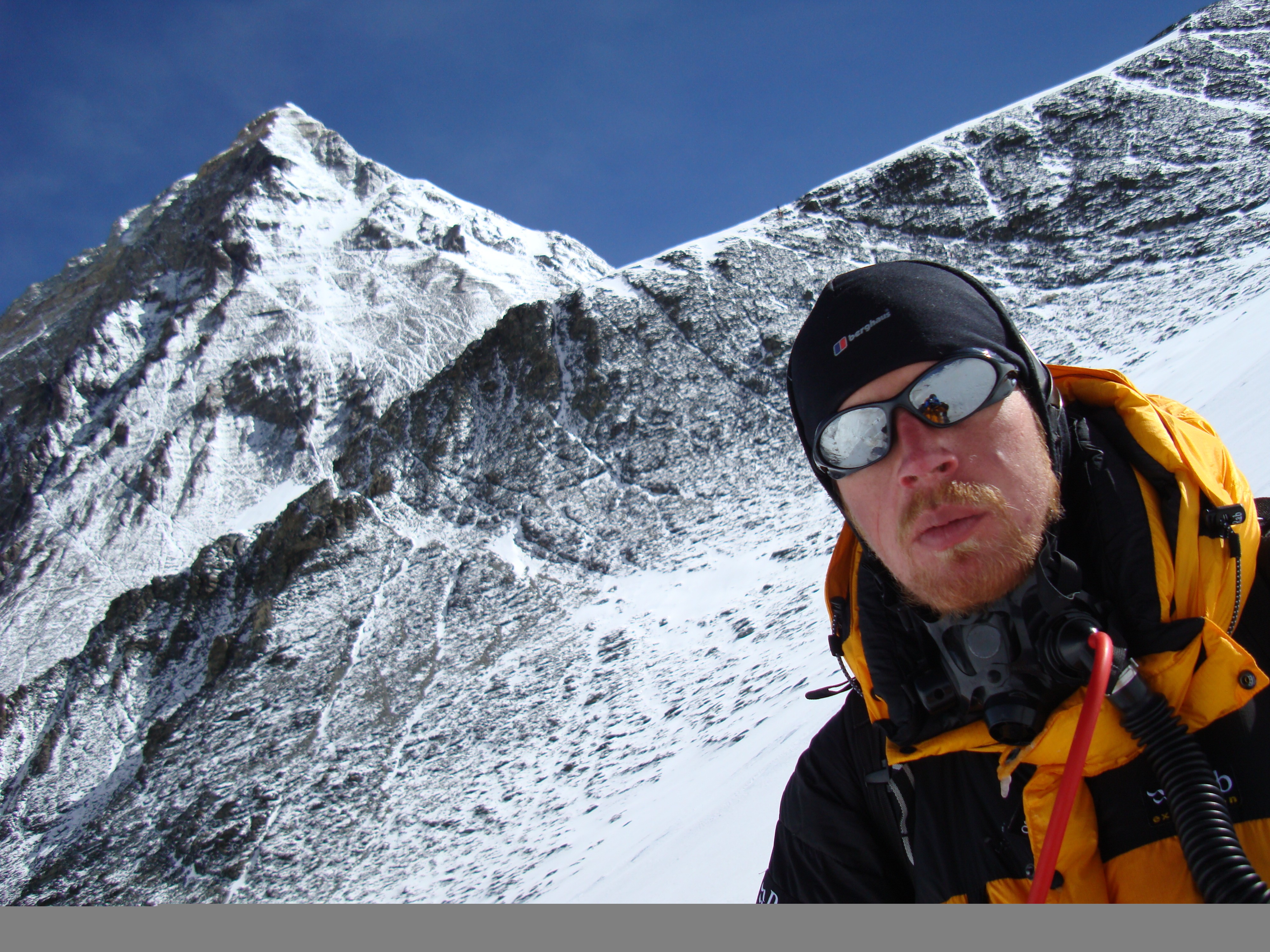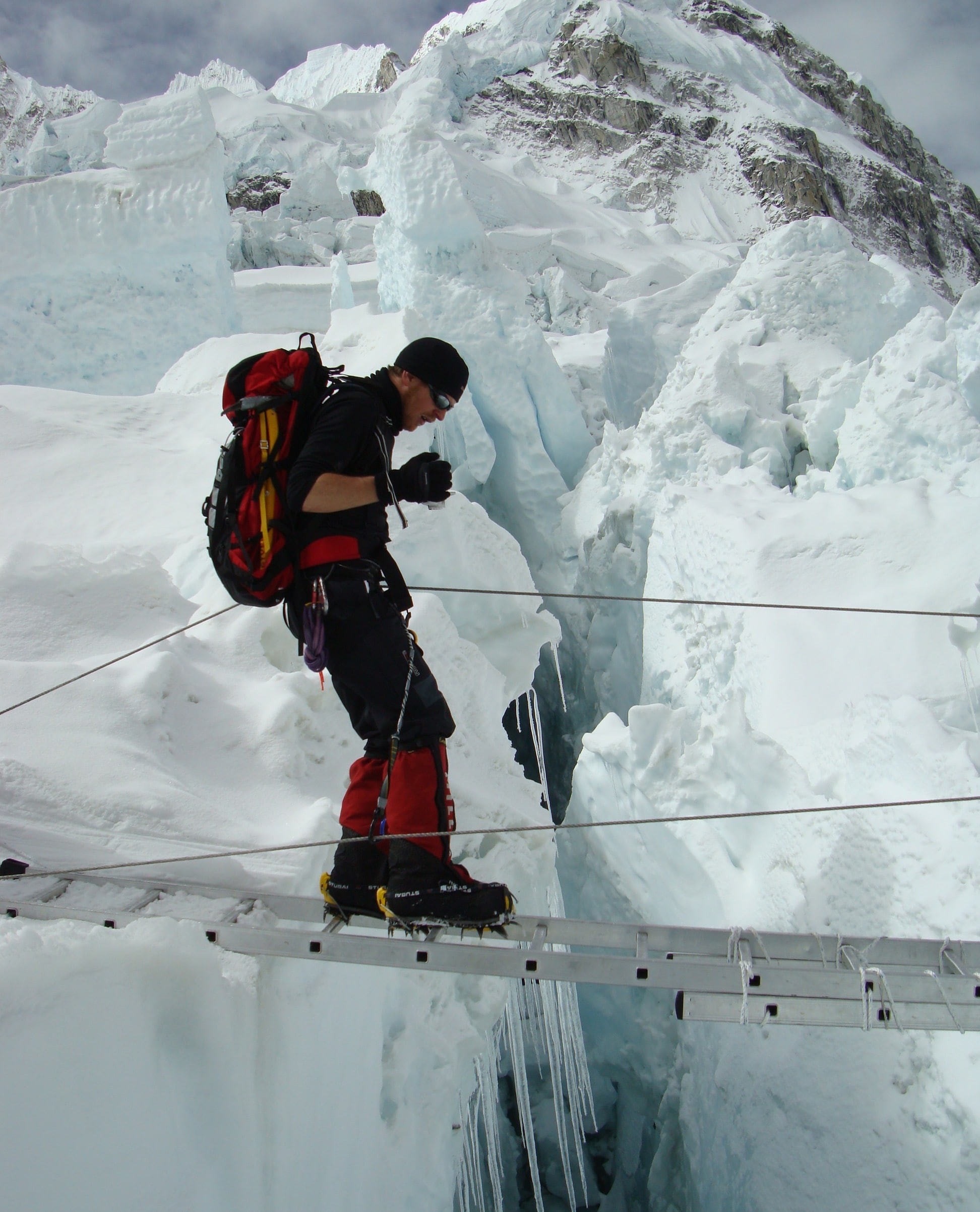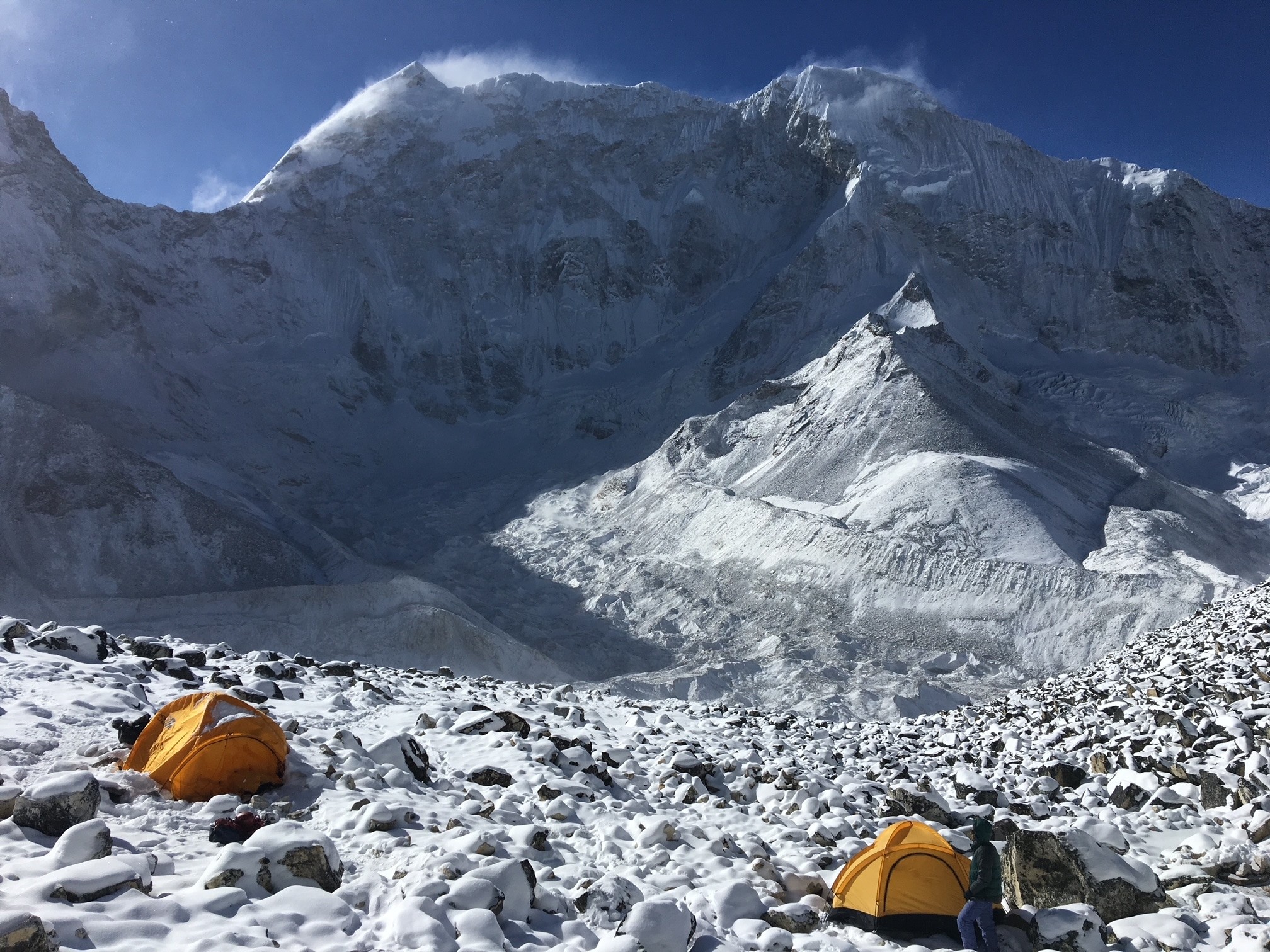Do You Need A Guide To Climb Mount Everest? Understanding the necessity of expert guidance for a safe and successful ascent is vital. CONDUCT.EDU.VN provides comprehensive resources to help you make informed decisions about your mountaineering endeavors, offering expert advice and safety guidelines. Exploring the ethical considerations and best practices in mountaineering, along with regulatory compliance, will empower you to approach this challenging feat responsibly.
1. When Dreams of Everest are Born
The idea of climbing Mount Everest often sparks from a deep-seated desire for adventure and achievement. It’s a goal that many dream of, envisioning themselves standing on the world’s highest peak. Like the author’s experience on a bus in the Peruvian Andes, a simple conversation can ignite a lifelong ambition. Everest Base Camp trek could be the first step of your lifetime dream.
Alt text: Picturesque view of Namche Bazaar, a key acclimatization point for Everest trekkers.
2. The Logical Progression of Mountains to Climb Before Everest
Before even contemplating an Everest climb, it’s crucial to build a solid foundation of mountaineering experience. Climbing various mountains of increasing difficulty helps develop the necessary skills, endurance, and high-altitude acclimatization. This progression also fosters self-sufficiency, reducing reliance on Sherpa support and minimizing risks.
2.1 Essential Mountains to Climb Before Everest
- Kilimanjaro: A non-technical climb that introduces you to altitude and multi-day trekking.
- Mont Blanc: Offers valuable experience in alpine climbing techniques.
- Elbrus: Another high-altitude peak that tests your endurance and acclimatization.
- Mera and Island Peaks: Provide experience with basic mountaineering skills and high-altitude environments.
- Cotopaxi and Chimborazo: Located in Ecuador, these volcanoes offer challenging climbs and acclimatization experience.
- Aconcagua: A significant step up in altitude and difficulty, preparing you for extreme conditions.
- Denali: A demanding climb in Alaska, known for its harsh weather and technical challenges.
2.2 The Importance of 8,000m Peaks
Climbing an 8,000-meter peak like Cho Oyu is highly recommended before attempting Everest. These peaks provide invaluable experience in extreme altitude, managing personal safety, and understanding your body’s response to such conditions. Successfully summiting an 8,000m peak demonstrates a level of preparedness essential for Everest.
3. The Ethical Considerations of Climbing Everest
Climbing Mount Everest involves significant ethical considerations. It’s essential to minimize the risks to Climbing Sherpas, who often bear the burden of carrying gear and setting up routes. Climbers should strive for self-sufficiency, carrying their own equipment whenever possible and limiting their reliance on external support.
3.1 Limiting Risk to Climbing Sherpas
Our office in Kathmandu works with experienced Climbing Sherpas. However, we should always consider their safety first. Reducing the risks they face should be a priority for every climber. This includes being adequately prepared, self-sufficient, and making responsible decisions on the mountain.
4. Setting Personal Goals for Everest
Setting clear, achievable goals is vital when planning an Everest expedition. For the author, the goal was to climb Everest as quickly as possible while also raising funds for charity. This involved meticulous planning, rigorous training, and a commitment to personal and ethical standards.
4.1 The Author’s Four-Mountain Challenge
The author set a goal to climb four mountains on four continents in one year:
- Mont Blanc (4,810m)
- Mount Kilimanjaro (5,895m)
- Aconcagua (6,962m)
- Mount Everest (8,848m)
This challenge aimed to raise $100,000 to build the Mt. Everest Primary school in Uganda with Irish Charity Fields of Life. Such ambitious goals require careful planning and unwavering dedication.
5. Training to Climb Mount Everest: A Comprehensive Guide
Proper training is paramount for a successful and safe Everest climb. This involves a structured approach, including base, build, and peak phases, each designed to enhance specific aspects of physical fitness.
5.1 Seeking Professional Advice
It’s crucial to seek professional advice on all fronts, including physical training, nutrition, and acclimatization strategies. A qualified trainer can develop a personalized plan tailored to your specific needs and goals.
Alt text: Mountaineer Ian Taylor during high-altitude training on Mount Everest.
5.2 Vo2 Max Testing
Undergoing a Vo2 Max test is essential to assess your body’s ability to transport and use oxygen during exercise. This test provides valuable insights into your physical fitness and helps tailor your training plan to improve your lung capacity and overall performance. The author’s Vo2 Max was 63 just before going to Mount Everest.
5.3 Base, Build, and Peak Phases of Training
- Base Phase: Focuses on building a solid foundation of cardiovascular fitness and muscular strength.
- Build Phase: Gradually increases the intensity and duration of training, incorporating more weight lifting and multi-day treks.
- Peak Phase: Emphasizes high-intensity interval training and long-duration endurance exercises to maximize fitness levels.
6. Additional Mountaineering Training
In addition to traditional gym and endurance training, it’s crucial to undertake specific mountaineering training in challenging environments. This includes practicing technical climbing skills, acclimatizing to high altitude, and testing your gear in harsh conditions.
6.1 Training in the Alps, Scotland, and Wales
Trips to the Alps, Scotland, and Wales offer invaluable opportunities to practice the specific training needed for Himalayan mountaineering. These locations provide diverse terrain and challenging weather conditions to hone your skills and build confidence.
6.2 The Harsh Conditions of Scotland
Training in the Scottish Highlands, particularly during the winter months, can be incredibly beneficial. The harsh conditions and technical terrain provide a realistic simulation of the challenges you’ll face on Everest.
7. The Mental Aspect of Climbing Everest
Climbing Everest is as much a mental challenge as it is a physical one. Developing mental resilience, managing fear, and maintaining a positive attitude are crucial for success. Experience in difficult conditions can significantly boost your mental fortitude.
7.1 The Importance of Mental Training
It’s often said that climbing Everest is 80% mental. Having extensive experience, testing your gear, and preparing for the psychological challenges are vital for overcoming obstacles and achieving your goal.
Alt text: Mountaineer filming the treacherous Khumbu Icefall on Mount Everest.
8. The First Peak of the Everest Challenge: Mont Blanc
After six months of hard training, climbing Mont Blanc marks the beginning of the build phase. This climb provides an opportunity to test your fitness and acclimatization strategies in a high-altitude environment.
8.1 Adding Weight Lifting and Multi-Day Treks
The build phase involves increasing the intensity of training by adding more weight lifting sessions and multi-day treks. This helps build strength, endurance, and mental resilience.
8.2 Trail Running in the Wicklow Mountains
Running trails in the Wicklow Mountains with a weighted backpack is an excellent way to improve cardiovascular fitness and build leg strength. Mixing up your training routine keeps you engaged and prevents plateaus.
9. The Second Peak of the Everest Challenge: Mount Kilimanjaro
Climbing Mount Kilimanjaro is a crucial step in preparing for Everest. It provides valuable experience in high-altitude trekking and allows you to assess your acclimatization capabilities.
9.1 Incorporating Interval Training
After climbing Kilimanjaro, it’s essential to incorporate interval training into your routine. This helps improve your cardiovascular fitness and prepares you for the intense physical demands of Everest.
9.2 The Importance of Rest and Recovery
Taking a full week off every eight weeks is crucial to allow your body to recover from the intense training. Adequate rest prevents injuries and ensures you’re fresh and ready for the next phase of your preparation.
10. The Third Peak of the Everest Challenge: Aconcagua
Summiting Aconcagua is a significant achievement that demonstrates your readiness for Everest. This climb tests your endurance, acclimatization, and technical skills in a challenging high-altitude environment.
10.1 The Peak Phase of Training
With two months remaining before flying to the Himalayas, the peak phase of training focuses on maintaining a high level of intensity and endurance. This includes interval training, long-duration hikes with a weighted backpack, and gym workouts.
10.2 Mental Strength and Confidence
The goal is to arrive at Everest with confidence and the knowledge that you’re physically and mentally prepared for the climb ahead. This mental strength is crucial for overcoming the many challenges you’ll face on the mountain.
Alt text: High camp setup on Island Peak, showcasing acclimatization and preparedness for high-altitude climbing.
11. The Fourth Peak: Mount Everest
Finally, the time comes to embark on the Everest expedition. Arriving in Kathmandu in peak physical condition is essential for a successful climb.
11.1 Acclimatization and Rotations
The Everest climb involves two weeks of trekking to Base Camp, followed by six weeks of climbing up and down the mountain to acclimatize to the lower levels of oxygen. These rotations are crucial for allowing your body to adapt to the altitude.
11.2 Pushing to Camp Three
One of the acclimatization rotations involves climbing to Camp Three at 7,200m on the Lhotse Face. Spending a night at this altitude tests your acclimatization and prepares you for the final summit push.
12. Standing on the Summit of Mount Everest
Reaching the summit of Mount Everest is the culmination of years of hard work, dedication, and preparation. It’s a moment of triumph that requires both physical and mental strength.
12.1 The Final Summit Push
The final summit push takes seven days to reach the top of Mount Everest and return back down. This requires careful planning, pacing, and unwavering determination.
12.2 Overcoming Fears and Achieving Dreams
Reaching the summit of Mount Everest is a testament to the power of perseverance and mental fortitude. It’s a reminder that with hard work and dedication, anything is possible.
Alt text: Ian Taylor triumphantly standing on the summit of Mount Everest in 2008.
13. Do You Need a Guide to Climb Mount Everest? A Deep Dive
Climbing Mount Everest is a monumental undertaking, and one of the first questions aspiring summiteers ask is: “Do I need a guide?” The answer isn’t a simple yes or no. It depends on a multitude of factors including your experience, skill level, comfort with risk, and even your budget.
13.1 Factors to Consider
- Experience: Have you climbed extensively at high altitudes? Are you familiar with technical climbing, crevasse rescue, and self-arrest techniques?
- Skills: Can you navigate in challenging terrain? Are you proficient in using mountaineering equipment like crampons, ice axes, and ropes?
- Risk Tolerance: Are you comfortable making life-or-death decisions in unpredictable conditions?
- Budget: Hiring a reputable guiding company is a significant investment. Can you afford the costs associated with experienced guides and support staff?
13.2 Benefits of Hiring a Guide
- Expertise and Safety: Guides bring years of experience and intimate knowledge of the mountain. They can assess risks, make informed decisions, and provide crucial support in emergencies.
- Logistical Support: Guiding companies handle permits, transportation, base camp setup, and other logistical complexities, freeing you to focus on the climb.
- Acclimatization Strategies: Experienced guides understand the importance of proper acclimatization and can tailor a plan to maximize your chances of success.
- Sherpa Support: Sherpas play a vital role in carrying gear, setting up camps, and fixing ropes, significantly increasing your safety and efficiency.
- Navigation and Route Finding: Guides are skilled navigators and can ensure you stay on the safest and most efficient route to the summit.
13.3 Potential Drawbacks of Using a Guide
- Cost: Guided expeditions are expensive, ranging from $40,000 to over $100,000 depending on the level of service and the guiding company.
- Loss of Independence: Some climbers prefer the freedom and challenge of self-guided ascents.
- Potential for Over-Reliance: Over-dependence on a guide can hinder your own decision-making abilities and self-reliance.
13.4 Is it Possible to Climb Everest Without a Guide?
While it is possible to climb Everest without a guide, it is significantly more challenging and dangerous. Unassisted climbs require exceptional experience, skill, and self-sufficiency. Climbers must be prepared to handle all aspects of the expedition themselves, including:
- Securing permits and visas
- Organizing transportation and logistics
- Establishing base camp and higher camps
- Carrying all gear and supplies
- Fixing ropes and navigating the route
- Managing medical emergencies
13.5 Ethical Considerations
Even if you choose to climb with a guide, it’s important to consider the ethical implications of your expedition. Support staff, including Sherpas, face significant risks and are often underpaid. Choose guiding companies that prioritize fair wages, safe working conditions, and environmental sustainability.
13.6 The Decision is Yours
Ultimately, the decision of whether or not to hire a guide to climb Mount Everest is a personal one. Carefully weigh the benefits and drawbacks, assess your own capabilities, and make an informed choice that aligns with your values and goals.
14. My New Goals
The author’s experiences on Everest have inspired new goals, including leading expeditions and sharing his knowledge with aspiring mountaineers.
14.1 Leading Expeditions and Sharing Expertise
Having led over 150 Expeditions and climbed 6 of the 7 summits, the author aims to continue sharing his expertise and inspiring others to pursue their mountaineering dreams.
14.2 Climbing Kilimanjaro for Charity
The author is aiming to climb Kilimanjaro 50 times for charity. This ongoing commitment demonstrates a dedication to giving back and making a positive impact.
15. Essential Gear for Climbing Mount Everest
Climbing Mount Everest demands specialized gear to withstand extreme conditions. Here’s a breakdown of essential equipment:
| Category | Item | Description |
|---|---|---|
| Clothing | Down Suit | Provides insulation in sub-zero temperatures. |
| Insulated Boots | Prevents frostbite; must be compatible with crampons. | |
| Thermal Base Layers | Moisture-wicking to keep dry. | |
| Fleece/Softshell Layers | Additional insulation and weather protection. | |
| Waterproof Outer Layers | Protection against wind, snow, and rain. | |
| Mountaineering | Ice Axe | For self-arrest and climbing steep sections. |
| Crampons | Attaches to boots for traction on ice and snow. | |
| Climbing Harness | For rope work and safety. | |
| Ascender/Jumar | Aids in ascending fixed ropes. | |
| Descender/Belay Device | For rappelling and controlled descent. | |
| Safety | Oxygen Mask and Regulator | Essential for breathing at high altitudes. |
| Avalanche Transceiver, Shovel, Probe | For avalanche safety. | |
| Helmet | Protects against falling ice and rocks. | |
| Personal | Backpack | To carry personal items and gear. |
| Headlamp | For navigating in the dark. | |
| Sunglasses/Goggles | Protects eyes from UV radiation and snow blindness. | |
| Sunscreen and Lip Balm | High SPF to prevent sunburn. | |
| Water Bottles/Hydration System | Staying hydrated is critical. | |
| First-Aid Kit | For treating minor injuries and ailments. |





16. The Role of Acclimatization in Conquering Everest
Acclimatization is the process by which your body adjusts to lower oxygen levels at high altitudes. Proper acclimatization is crucial for preventing altitude sickness and ensuring a safe and successful climb.
16.1 How Acclimatization Works
As you ascend to higher altitudes, your body responds by:
- Increasing Red Blood Cell Production: To carry more oxygen.
- Breathing Faster and Deeper: To take in more oxygen.
- Releasing More of a Chemical Called DPG: This helps release oxygen from hemoglobin to body tissues.
- Kidneys Excrete More Fluid: This increases concentration of red blood cells.
16.2 Acclimatization Strategies
- Gradual Ascent: Ascend slowly, allowing your body time to adjust to the altitude.
- Rest Days: Incorporate rest days into your itinerary to allow your body to recover.
- Climb High, Sleep Low: Climb to a higher altitude during the day and descend to a lower altitude to sleep.
- Hydration and Nutrition: Drink plenty of fluids and eat a balanced diet to support your body’s acclimatization efforts.
16.3 Recognizing and Treating Altitude Sickness
It’s essential to recognize the symptoms of altitude sickness and take appropriate action. Symptoms can range from mild (headache, nausea, fatigue) to severe (HAPE, HACE).
- Mild Altitude Sickness: Rest, hydrate, and avoid further ascent.
- Severe Altitude Sickness: Descend immediately and seek medical attention.
17. Navigating the Khumbu Icefall: A Perilous Passage
The Khumbu Icefall is one of the most dangerous sections of the Everest climb. This constantly shifting glacier is a maze of crevasses and towering ice seracs that can collapse without warning.
17.1 The Risks of the Icefall
- Crevasses: Deep cracks in the ice that can be hidden by snow.
- Seracs: Large blocks of ice that can collapse and cause avalanches.
- Unpredictable Movement: The icefall is constantly moving and changing, making it difficult to predict where it’s safe to travel.
17.2 Safety Measures
- Fixed Ropes and Ladders: These are used to navigate crevasses and steep sections.
- Careful Route Selection: Guides choose the safest possible route through the icefall.
- Early Morning Ascents: The icefall is more stable in the early morning when temperatures are colder.
- Experience and Skill: Navigating the icefall requires exceptional mountaineering skills and experience.
18. Communicating on Everest: Staying Connected
Staying connected on Everest is essential for safety and communication with the outside world. Technology has made it easier than ever to stay in touch, but it’s important to choose the right communication methods and understand their limitations.
18.1 Communication Options
- Satellite Phones: Provide reliable voice communication, but can be expensive.
- Satellite Internet: Allows you to send emails and access the internet, but speeds can be slow.
- Two-Way Radios: Used for communication between team members on the mountain.
18.2 Charging Devices
- Solar Chargers: Can be used to charge devices in sunny conditions.
- Portable Power Banks: Provide a backup power source.
19. Health and Hygiene on the Mountain
Maintaining health and hygiene on Everest is crucial for preventing illness and staying strong during the climb.
19.1 Preventing Illness
- Hygiene: Wash your hands frequently and use hand sanitizer.
- Water: Drink plenty of clean water.
- Nutrition: Eat a balanced diet to maintain your energy levels.
- Rest: Get enough sleep to allow your body to recover.
19.2 Medical Support
- Expedition Doctors: Many expeditions have a doctor on staff to provide medical care.
- First-Aid Kits: Carry a well-stocked first-aid kit with essential medications.
20. Understanding Weather Patterns on Everest
The weather on Everest is notoriously unpredictable and can change rapidly. Understanding weather patterns and forecasts is crucial for making informed decisions and staying safe.
20.1 Key Weather Factors
- Temperature: Can range from above freezing at base camp to -40°C (-40°F) or lower at the summit.
- Wind: High winds can make climbing extremely difficult and dangerous.
- Precipitation: Snow and rain can create slippery conditions and increase the risk of avalanches.
20.2 Sources of Weather Information
- Meteorological Services: Provide forecasts specific to the Everest region.
- Local Knowledge: Guides have valuable insights into local weather patterns.
21. Honoring Sherpa Culture and Contributions
Sherpas are an integral part of the Everest climbing community. They provide invaluable support, guidance, and expertise. It’s essential to honor their culture and contributions.
21.1 Respecting Sherpa Traditions
- Learn about Sherpa culture and traditions.
- Show respect for their beliefs and customs.
- Support Sherpa-owned businesses.
21.2 Fair Labor Practices
- Ensure Sherpas are paid fair wages.
- Provide safe working conditions.
- Support organizations that advocate for Sherpa rights.
22. Managing Waste and Environmental Impact
Everest has suffered from significant environmental degradation due to waste and pollution. It’s essential to minimize your environmental impact and follow responsible waste management practices.
22.1 Waste Management Strategies
- Pack out all trash.
- Use designated toilet facilities.
- Avoid polluting water sources.
22.2 Supporting Environmental Initiatives
- Support organizations that clean up Everest.
- Promote sustainable climbing practices.
23. The Future of Everest Climbing
The future of Everest climbing will likely involve greater emphasis on sustainability, safety, and ethical practices.
23.1 Sustainable Climbing Practices
- Limiting the number of permits issued.
- Promoting responsible waste management.
- Supporting local communities.
23.2 Enhanced Safety Measures
- Improved weather forecasting.
- Advanced medical support.
- Better training for climbers and guides.
24. Staying Informed on Everest Regulations
Climbing Mount Everest is subject to regulations set by the Nepalese government and other organizations. Staying informed about these regulations is crucial for compliance and safety.
24.1 Key Regulatory Bodies
- Ministry of Culture, Tourism and Civil Aviation (Nepal): Responsible for issuing permits and setting regulations for climbing Everest.
- Nepal Mountaineering Association (NMA): Works to promote responsible mountaineering practices in Nepal.
24.2 Understanding Permit Requirements
- Obtain the necessary permits well in advance of your climb.
- Familiarize yourself with the conditions and restrictions of your permit.
25. Frequently Asked Questions (FAQ) about Climbing Mount Everest
Here are some frequently asked questions about climbing Mount Everest:
-
How much does it cost to climb Mount Everest?
- The cost can range from $40,000 to $100,000 or more, depending on the guiding company and level of service.
-
How long does it take to climb Mount Everest?
- The entire expedition typically takes around 60 to 75 days, including trekking to base camp, acclimatization, and the summit attempt.
-
What are the biggest risks of climbing Mount Everest?
- Altitude sickness, avalanches, falls, crevasse falls, and extreme weather.
-
How physically fit do I need to be to climb Mount Everest?
- You need to be in excellent physical condition with a high level of cardiovascular fitness, strength, and endurance.
-
What experience do I need to climb Mount Everest?
- Extensive high-altitude mountaineering experience is essential, including climbing other 6,000m and 7,000m peaks.
-
What is the best time of year to climb Mount Everest?
- The best time is during the pre-monsoon season (April-May) or post-monsoon season (September-October).
-
Do I need to speak Nepali to climb Mount Everest?
- While not essential, learning some basic Nepali phrases can be helpful and show respect for the local culture.
-
What is the success rate of climbing Mount Everest?
- The success rate varies depending on the year and the experience of the climbers, but it is typically around 50%.
-
What happens if I get sick or injured on Mount Everest?
- Expeditions typically have a doctor or medic on staff who can provide medical care. In serious cases, evacuation by helicopter may be necessary.
-
What are the ethical considerations of climbing Mount Everest?
- Minimizing risks to Sherpas, responsible waste management, and respecting local culture are important ethical considerations.
26. Conclusion: Your Everest Journey Starts Here
Climbing Mount Everest is an extraordinary challenge that demands meticulous preparation, unwavering dedication, and a deep respect for the mountain and its people. Whether you choose to climb with a guide or embark on a self-guided ascent, understanding the risks, ethical considerations, and regulatory requirements is essential for a safe and successful expedition.
26.1 Ready to Learn More?
Are you ready to take the first step towards your Everest dream? Visit CONDUCT.EDU.VN for comprehensive resources, expert advice, and safety guidelines to help you prepare for this incredible journey. Contact us at 100 Ethics Plaza, Guideline City, CA 90210, United States, or WhatsApp +1 (707) 555-1234. Let conduct.edu.vn be your trusted guide on the path to conquering the world’s highest peak. Remember, responsible climbing begins with informed decisions.